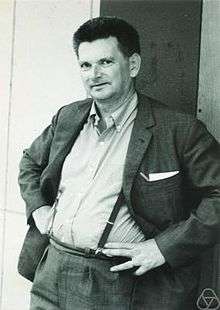René Thom
| René Thom | |
|---|---|
 René Thom in Nice, 1970 | |
| Born |
2 September 1923 Montbéliard, France |
| Died |
25 October 2002 (aged 79) Bures-sur-Yvette, France |
| Nationality | French |
| Fields | Mathematics |
| Institutions |
University of Strasbourg Université Joseph Fourier Institut des Hautes Études Scientifiques |
| Alma mater | École Normale Supérieure, University of Paris |
| Thesis | Espaces fibres en spheres et carres de Steenrod (1951) |
| Doctoral advisor | Henri Cartan |
| Doctoral students |
Daniel Bennequin Marc Chaperon Marcos Sebastiani David Trotman |
| Known for | topology |
| Notable awards | Fields Medal in 1958 |
René Frédéric Thom (French: [ʁəne tõ]; 2 September 1923 – 25 October 2002) was a French mathematician. He made his reputation as a topologist, moving on to aspects of what would be called singularity theory; he became world-famous among the wider academic community and the educated general public for one aspect of this latter interest, his work as founder of catastrophe theory (later developed by Erik Christopher Zeeman). He received the Fields Medal in 1958.
Biography
René Thom was born in Montbéliard, Doubs. He was educated at the Lycée Saint-Louis and the École Normale Supérieure, both in Paris. He received his PhD in 1951 from the University of Paris. His thesis, titled Espaces fibrés en sphères et carrés de Steenrod (Sphere bundles and Steenrod squares), was written under the direction of Henri Cartan. The foundations of cobordism theory, for which he received the Fields Medal at Edinburgh in 1958, were already present in his thesis.
After a fellowship in the United States, he went on to teach at the Universities of Grenoble (1953–1954) and Strasbourg (1954–1963), where he was appointed Professor in 1957. In 1964, he moved to the Institut des Hautes Études Scientifiques, in Bures-sur-Yvette. He was awarded the Brouwer Medal in 1970, the Grand Prix Scientifique de la Ville de Paris in 1974, and became a Member of the Academie des Sciences of Paris in 1976.
While René Thom is most known to the public for his development of catastrophe theory between 1968 and 1972, his earlier work was on differential topology. In the early 1950s it concerned what are now called Thom spaces, characteristic classes, cobordism theory, and the Thom transversality theorem. Another example of this line of work is the Thom conjecture, versions of which have been investigated using gauge theory. From the mid 1950s he moved into singularity theory, of which catastrophe theory is just one aspect, and in a series of deep (and at the time obscure) papers between 1960 and 1969 developed the theory of stratified sets and stratified maps, proving a basic stratified isotopy theorem describing the local conical structure of Whitney stratified sets, now known as the Thom-Mather isotopy theorem. Much of his work on stratified sets was developed so as to understand the notion of topologically stable maps, and to eventually prove the result that the set of topologically stable mappings between two smooth manifolds is a dense set. Thom's lectures on the stability of differentiable mappings, given at Bonn in 1960, were written up by Harold Levine and published in the proceedings of a year long symposium on singularities at Liverpool University during 1969-70, edited by Terry Wall. The proof of the density of topologically stable mappings was completed by John Mather in 1970, based on the ideas developed by Thom in the previous ten years. A coherent detailed account was published in 1976 by C. Gibson, K. Wirthmuller, E. Looijenga and A. du Plessis.
During the last twenty years of his life Thom's published work was mainly in philosophy and epistemology, and he undertook a reevaluation of Aristotle's writings on science. In 1992, he was one of eighteen academics who sent a letter to Cambridge University protesting against plans to award Jacques Derrida an honorary doctorate.
Beyond Thom's contributions to algebraic topology, he studied differentiable mappings, through the study of generic properties.
See also
- Dold–Thom theorem
- Heisuke Hironaka
- Quelques propriétés globales des variétés differentiables
- Thom isomorphism
- Pontryagin-Thom construction
- Thom–Porteous formula
Bibliography
- "Espaces fibrés en sphères et carrés de Steenrod", Annales Scientifiques de l'École Normale Supérieure (3) 69, (1952), 109–182.
- Thom, René (1954), "Quelques propriétés globales des variétés différentiables", Commentarii Mathematici Helvetici, 28: 17–86, doi:10.1007/BF02566923, MR 0061823
- "Ensembles et morphismes stratifiés", Bulletin of the American Mathematical Society 75 (1969), 240–284.
- "Semio Physics: A Sketch", Addison Wesley, (1990), ISBN 0-201-50060-4
- Structural Stability and Morphogenesis, W. A. Benjamin, (1972), ISBN 0-201-40685-3.
References
- Logos et Théorie des Catastrophes: à partir de l’oeuvre de René Thom, ed. Jean Petitot. Colloque de Cerisy-la-Salle 1982 (Patiño, Geneva 1996), ISBN 9782882130105
- David Aubin, "Forms of Explanations in the Catastrophe Theory of René Thom: Topology, Morphogenesis, and Structuralism," in Growing Explanations: Historical Perspective on the Sciences of Complexity, ed. M. N. Wise, Durham: Duke University Press, 2004, 95-130.
- Brian J. Reilly, “René Thom,” in The Columbia History of Twentieth-Century French Thought. ed. Lawrence D. Kritzman. New York: Columbia University Press, 2006. pp. 663–666.
- Martin Weil, French Mathematician René Thom Dies, Washington Post, November 17 (2002), p. C10
External links
| Wikimedia Commons has media related to René Thom. |
- O'Connor, John J.; Robertson, Edmund F., "René Thom", MacTutor History of Mathematics archive, University of St Andrews.
- Washington Post Online edition (free registration)
- Meeting René THOM